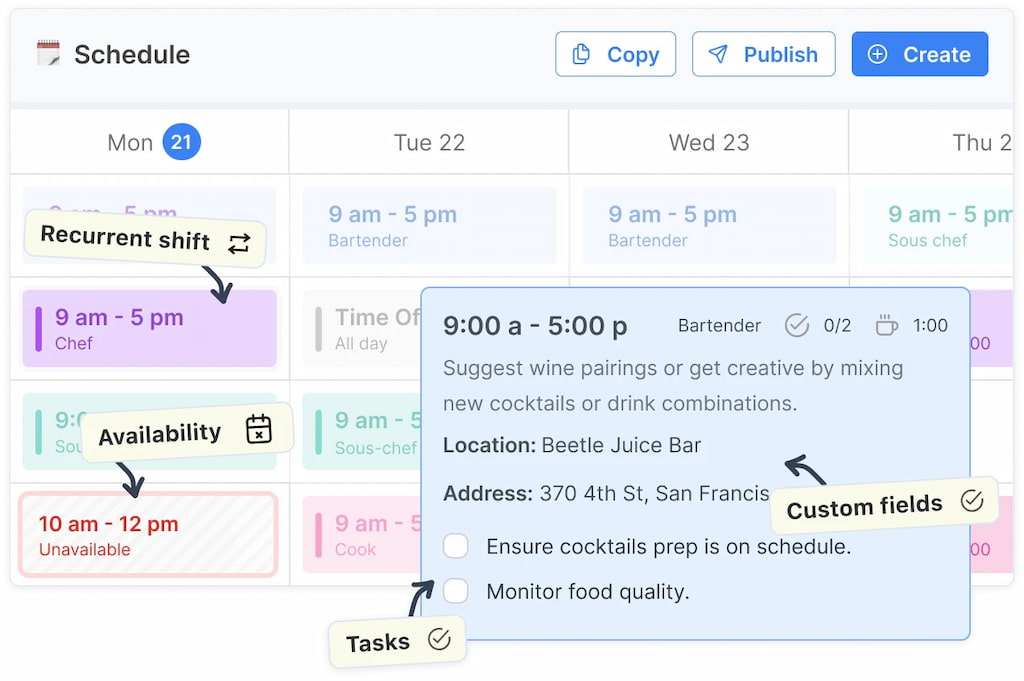It’s a high-volume Tuesday afternoon. Calls flood in, agents are juggling chats and phone queues, one team member forgets to log out of the wrong queue—and suddenly service level slips, wait times climb, and your budget takes a hit. What was supposed to be smooth ops now feels like firefighting. For modern call centers, managing agents, forecasted demand, channels and schedules manually just won’t cut it. That’s why the the best free employee scheduling app matters. In this article you’ll learn what is the best workforce management software for call centers, what it really means in 2025, the features that drive results, how to integrate tools like Shifts by Everhour naturally in the workflow, and which platforms lead the pack for scheduling, forecasting and agent management.
What Is Workforce Management Software for Call Centers?
Workforce management (WFM) software for call centers is a specialised platform that helps ensure the right agents are in the right place at the right time to meet customer demand. It covers forecasting call volumes, scheduling agents, tracking adherence, managing intraday changes, and analysing performance metrics. In 2025, the relevance of this software has never been stronger because:
- 📞 Customer expectations demand shorter wait times and higher availability across channels.
- 🏠 Hybrid workforce models mean agents may be remote, part-time, or working cross-channel, increasing scheduling complexity.
- 💰 Budget pressure demands tighter staffing, fewer idle agents, and better alignment between demand and supply.
- 🤖 Analytics and AI capability make it possible to optimise rather than over-staff.
- ⚖️ Compliance factors (hours, breaks, skills) add additional scheduling complexity beyond simply “who is available.”
Whether you run a 20-agent in-house team or a 200-seat outbound center, workforce management software is the operational backbone that turns planning into performance.
Key Features & Use Cases
📊 Forecasting & demand planning
Good workforce management starts with predicting call volumes, required staffing, and the right skill mix. For example, when inbound chat spikes at 10 AM, you need enough agents skilled in both chat and phone.
💡 Use case: during the holiday season, you forecast a 30% increase in Saturday morning volume—so you schedule additional agents to cover demand.
🗓 Scheduling & skill-based allocation
Once demand is forecasted, you build schedules that match agent availability, multi-channel coverage, and absence buffers. This includes managing shift swaps, time-off, and intraday adjustments.
💡 Use case: a remote agent logged into the phone queue after hours could be switched to SMS chat to maintain productivity.
⚡ Real-time adherence & intraday management
Schedules are never static. Agents may log in late, calls can surge, or coverage may drop. WFM tools provide real-time dashboards, alerts for understaffed shifts, and options for quick reassignments.
💡 Use case: at 3 PM, the chat queue doubles—so the system triggers a shift swap from an idle phone agent to the chat channel.
📈 Analytics & performance metrics
Beyond schedule accuracy, modern WFM provides insights into agent performance, skill utilization, idle time, and overtime trends. This data supports better planning and staffing decisions.
💡 Use case: a weekly report shows idle time 12% higher than expected on Fridays—so you adjust schedules the following month.
🔗 Integration with scheduling & time-tracking systems
WFM doesn’t operate in isolation. It should connect to scheduling tools (for planned staffing) and time tracking systems (for actual hours worked). This creates a unified workflow where planning and execution align seamlessly—for example, by linking with Shifts by Everhour to coordinate schedules and time logs across channels.
🧠 Top Workforce Management Software for Call Centers
| Tool | Key Features | Pricing/Plan | Ideal For |
| Shifts by Everhour | Shift scheduling; real-time time tracking; mobile app; schedule vs actual analytics; intraday coverage alerts | Free & paid plans | Call centers that want scheduling and live time-tracking for agents in one workflow |
| NICE Workforce Management | Forecasting; schedule optimisation; intraday adherence; multi-channel agent scheduling; analytics | Enterprise licensing | Mid-to-large contact centres needing full WFM suite |
| Verint Workforce Management | Skills-based scheduling; mobile agent portal; forecasting; adherence and shrinkage controls | Enterprise licensing | Contact centres focused on agent experience and compliance |
| Calabrio ONE | AI-powered forecasting; agent engagement portal; shift planning; coaching integration | Enterprise licensing | Operations aiming to combine WFM with performance management |
| Playvox Workforce Management | AI-driven scheduling; labour analytics; shift/swaps support; omnichannel WFM | Paid plans | Growing call centres seeking flexible cloud-based WFM |
| Talkdesk Workforce Management | Automated scheduling; real-time dashboards; AI-powered forecasting; mobile agent access | Paid plans | Cloud-first contact centres focused on ease of use and agility |
| RingCentral Contact Center WFM | Add-on WFM module; auto-schedule; mobile swap/time-off; labour cost dashboards | Paid plans | Call centres already using RingCentral looking to add WFM |
| Assembled WFM | Cloud scheduling; adherence tracking; reporting; shift swap; multi-channel agent management | Paid plans | Small-to-mid contact centres wanting modern SaaS WFM |
| Agentis | Forecasting; schedule optimisation; intraday management; analytics; agent portal | Enterprise licensing | Large global contact centres with complex shifts and compliance needs |
Quick tool highlights
- Shifts by Everhour: Best for smaller or mid-sized call centres that need scheduling and real-time tracking in a unified system.
- NICE Workforce Management: A market leader, offers deep WFM functionality for large scale operations.
- Verint Workforce Management: Strong mobile agent support and compliance features, great for multi-channel global teams.
- Calabrio ONE: Combines WFM with agent engagement and performance—good if you want WFM plus coaching.
- Playvox Workforce Management: Flexible cloud option with AI-driven scheduling—ideal for growth-stage contact centres.
- Talkdesk Workforce Management: SaaS-native, streamlined interface and solid scheduling/forecasting for modern teams.
- RingCentral Contact Center WFM: Ideal if you already use RingCentral and want to add WFM module without changing core telephony.
- Assembled WFM: Sleek, modern SaaS WFM tool tailored to smaller centres looking for ease of use.
- Agentis: Built for large-scale enterprise contact centres with high complexity and global operations.
Why Shifts by Everhour Belongs
While many vendors focus purely on forecasting or queue management, integrating scheduling and live time tracking is crucial — and that’s where Shifts by Everhour shines for call centres. Here’s how it fits:
- 🗓 You build agent schedules in Shifts with roles (phone, chat, email), locations (onsite, remote), and shift details

- ⏱ Agents clock in/out and log time against those shifts — capturing actual worked hours vs planned
- 📊 WFM software leverages data for forecast accuracy, schedule adherence, overtime tracking, and skill utilisation
- ⚡ Real-time updates: if an agent logs out early, the schedule shows the gap and triggers coverage adjustments
- 💡 The result: fewer overstaffed windows, improved adherence, and better alignment between labour cost and customer demand
Put simply: scheduling + time tracking + analytics = strong workforce management.
If your call centre still relies on spreadsheets or separate systems, integrating via Shifts by Everhour dramatically boosts visibility and control.
📕 Best Practices & Actionable Tips
- 📊 Use historical data to build your baseline forecast — but adjust for seasonality, promotions, and channel shifts
- 🧑💼 Define agent roles and skills clearly (phone, chat, email, SMS) — then schedule based on both role and volume
- 📅 Publish schedules early and give agents mobile access for visibility and flexibility
- ⚡ Build buffer capacity and cross-skill coverage so you can pivot during intraday surges
- ⏱ Monitor schedule adherence daily — when agents deviate, review causes (late login, break overrun, queue shift) and adjust next day
- 🔗 Integrate scheduling tool with tracking and payroll to eliminate data silos and manual reconciliation
- 📈 Use analytics to identify times of chronic understaffing or overstaffing — then refine your plan accordingly
- 🤝 Promote agent self-service (time off, shift swap, availability) to reduce admin burden and improve satisfaction
FAQ Section
What exactly is “workforce management” in a call-center context?
Workforce management includes forecasting contact volume, scheduling agents by skill and channel, tracking adherence, managing intra-day shifts, and analysing performance metrics.
Why can’t we just use spreadsheets and manual scheduling?
Spreadsheets don’t scale. They lack real-time updates, forecasting accuracy, adherence tracking and multi-channel intelligence. According to Calabrio, automation saves about 25 % of manual scheduling time.
How does scheduling integrate with WFM?
Scheduling is a core part of WFM—but WFM also brings forecasting, intraday management and performance analytics. A good schedule is the outcome; WFM is the process and system.
What metrics should I track in WFM?
Key metrics include schedule adherence, average handle time (AHT), occupancy, shrinkage, idle time, agent utilisation, and forecast accuracy.
Will a WFM tool help if my agents work remote or hybrid?
Yes—modern WFM tools support mobile agent portals, handle flexible scheduling, and maintain visibility even when agents are remote. Verint highlights improved employee experience through mobile scheduling.
How long does it take to implement a WFM system?
It depends on complexity—smaller centres may go live in a few weeks; large, global centres with multi-channel routing and compliance may take several months. Start with core scheduling then expand forecasting and analytics.
Final Thoughts: Best Workforce Management Software for Call Centers
Choosing the right workforce management software is about more than picking a tool—it’s about embedding planning, scheduling and analytics into your operational DNA so your call centre stays responsive, efficient and agent-friendly. Key selection criteria in 2025 include forecasting accuracy, skill-based scheduling, real-time adherence management, analytics and integration with scheduling/time-tracking systems. And if you’re looking for a solution that brings scheduling and actual worked-time together, Shifts by Everhour deserves serious consideration.
If managing shifts, agent availability and time-tracking still feels like your daily grind, it may be worth giving Everhour a try.
If you’re looking for a seamless way to improve shift planning, Shifts by Everhour is the best staff scheduling system. With features like real-time monitoring, easy scheduling, and mobile accessibility, managing your workforce has never been simpler.
🔎 Make sure to check out the best call center automation software!

